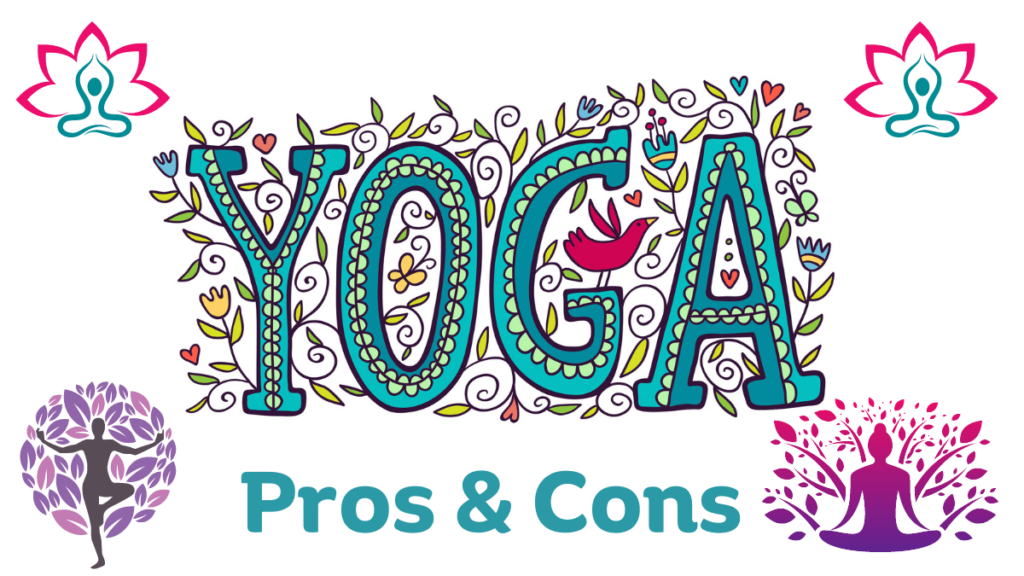
The beauty of yoga is that almost everyone can do it.
It is not a requirement for you to be a yogi or yogini to practice it. No matter what your age or level of fitness is, you can reap the benefits of yoga.
However, if you have some health issues, it is best to consult your medical health care provider first. Since the purpose of yoga is to unite the body and mind to cultivate awareness, a higher level of consciousness, self-regulation, and discernment; one must observe and do the appropriate procedures.
That being said, no matter whether you are a beginner or an active practitioner, you must keep in mind all the pros and cons of yoga. To start, let us talk about the pros first.
Pros of Yoga
If you are just a beginner in this practice, the advantages and disadvantages of yoga are essential for you to know. According to medical research, there are no side effects.
Still, you might be wondering what are the pros and cons of yoga before you start doing it. Among all the exercises, yoga is the safest and features the following pros:
1. Increases Flexibility
Yoga involves a lot of stretching which when practiced actively, will improve your flexibility.
However, some people believe the common myth – you need to be flexible enough to perform it. They consider their lack of flexibility a disadvantage, but I am here to tell you that this is not true.
In fact, anyone can start gradually implementing yoga and over time, their flexibility will be greatly improved. Being active and persistent will eventually relax your muscles and improve the motion of your ligaments and tendons.
This will also increase your overall range of motion, reducing the risk of any exercise-related injury.
Yoga has a particular advantage that strengthens and loosens the hip joints, which allows better coordination of hip hinge movements.
Hence, improving the flexibility of your hip joints reduces the amount of stress placed on the joints during exercise. In the long run, this means that it will be less likely that you will suffer a painful knee or joint injury.
2. Improves Posture
With regular yoga practice, you will see the evident correction of your poor posture. In our society, a not-so-good posture results from not sitting correctly because of either long hours of desk work or cell phone fixation.
A lack of exercise can also cause similar issues. Luckily, the practice of yoga focuses on maintaining proper alignment when you slouch and strengthening your muscles. It helps improve your posture while also allowing your body to function efficiently.

3. Reduces Anxiety and Stress
Another advantage of yoga is anxiety and stress relief. For this reason, many want to experience yoga since relaxation is their end goal.
Yoga being a mind and body practice affects your mind, body, and soul. With integrative and complementary health procedures, yoga can help you achieve peace since it brings together physical and mental disciplines.
The breathing exercises also bring you to a tranquil state – that will allow you to relax and better manage your stress and anxiety levels.
Also, the physical yoga positions improve flexibility, enhance concentration, reduce tension, and alleviate pain. It may assist you in releasing physical obstructions such as muscular knots, as well as emotional and stress.
4. Builds on Focus
The goal of yoga is to bring your focus back to the present moment, while it observes your breathing and slows down your thoughts.
This mindfulness aspect of yoga gives peacefulness between your mind and body. It allows you to achieve a state of relaxation and promotes a much healthier mental state. It can also be beneficial to students in a variety of ways.
Yoga postures, breathing exercises, and meditation, when done mindfully, can help you concentrate more effectively. It enhances your memory and helps in the memorization of study guides when you have exams.
Yoga not only benefits your memory and concentration but also people suffering from irritability tendencies.

5. Enhances Athletic Performance
Athletes can gain so many benefits from yoga exercises, specifically to gain strength, flexibility, and balance. It may aid in the improvement of your range of motion, mobility, and coordination, all of which can improve your performance and help you avoid injury in the long run.
With yoga, there will be an enhancement of athletic stamina and immunity. This will allow you to perform better in sports and at the gym. Therefore, maximum power, speed, and strength are the ultimate goals of practicing yoga.
It is true that the more you practice, the more flexible you get. Also, a toned body is another benefit.
Since athletes need a toned body to perform better in sports, yoga helps them understand their bodies thoroughly and improve their balance. As a result, you can get toned and sculpted muscles.
6. Detoxifies Body
As other fitness programs do, another benefit of yoga includes aid in the detoxing of the body. However, before you start thinking about fitness programs, examining your diet to ensure that you are not consuming toxic foods that contribute to the waste is necessary.
Following this, you can begin your daily yoga exercises and take advantage of its postures. There are specific parts of your body that you should move to help you get rid of toxins.
Many yoga postures improve blood circulation, stimulate the lymphatic system, and assist the liver in performing its cleansing functions to the greatest extent possible. It can assist you in detoxifying your body and mind if you follow the proper routine.
The everyday practice may aid in the elimination of undesirable pollutants from your systems, such as carbon dioxide, lactic acid, and lymphatic fluid, among other things. Alongside that, it also allows the blood to flow to the organs and lets them function properly.
The most beneficial yoga routine for your daily detoxing practice will generally include numerous inversions, forward bends, and twists.

7. Benefits Cardiovascular Health
One thing to keep in mind about yoga is its benefit to your cardiovascular or heart health. It is primarily because practicing can help people relieve stress and lower the cortisol levels in their bodies.
The fact that stressing is terrible for the heart should come as no surprise to anyone. As we all know, high blood pressure can lead to a variety of heart problems. Practicing yoga helps to control stress and excessive cortisol levels, and by that, it can prevent high blood pressure.
Aside from the obvious benefits of regular aerobic yoga sessions – increased cardiovascular endurance, improved heart health, and a happier and healthier lifestyle are other merits.
8. Treats Chronic Pain
Medical studies prove that yoga provides our bodies with the much-needed essentials and optimal flexibility. As a result, yoga helps in keeping our bodies flexible, which reduces the risk of developing critical conditions such as arthritis and osteoarthritis in the future.
With that, yoga, alongside a professional physical therapy program; is beneficial in reducing chronic pain and strengthening the muscles in the area causing you problems.
As mentioned earlier, it helps in posture correction and the body to function accordingly, thus helping in healing the chronic pain in your joints. This happens because yoga can help bring the body into balance by increasing strength, releasing muscle tension, improving flexibility, and strengthening joints and bones – ultimately alleviating the pain.

Cons of Yoga
Although it is a good practice for everyone, there are still a few cons. This is something you have to consider when learning about the pros and cons of yoga.
Since it involves difficult positions, you should know that there are risks in yoga.
With that in mind, it is also necessary to know who should not do yoga. Knowing these things can help you prevent the negative effects. So, here is a list of its cons:
1. Expensive Yoga Sessions
Yoga is costly because it is popular and beneficial to our health. Many people are interested in practicing, so the studios can charge higher prices to entice people into their establishments.
Aside from that, the high overhead cost of a studio is one of the reasons why the prices are so high. When you consider the amount you pay for a class and the number of expenses you incur, the cost of your class may become more reasonable to you.
Yoga studios are also restricted in the number of times they can hold classes. People will likely be busy for the majority of the day. As a result, classes may only be available in the early morning and late afternoon hours as a result of scheduling constraints.
This eliminates a significant amount of potential income that a studio could have earned so, pricing higher is a way to resolve it.

2. Risky When Done Inappropriately
There are some risks in yoga that can occur when executed wrong. When you’re a beginner, it’s not recommended for you to do difficult positions. Always seek help from professional instructors. You should not jump right into the advanced level without learning first the simple yoga exercises.
The majority of practitioners make the same mistake, which causes physical discomfort. As with any physical fitness program in which you stretch your body to gain muscle power, you should avoid stretching your body beyond its limits because you will injure your body and end up with torn muscles as a result of doing so. You cannot build muscle overnight.
This is one of the reasons why you may experience the negative effects of yoga. Let it be known that exercising daily and adherence to the program’s guidelines is vital.

3. It Requires Time
It will take a long time for you to see the full results of your practice. That’s why it requires time and commitment. If you can’t commit to your schedule, you might not experience your desired results.
If you’re the type of person who wants to see instant results, then you might be someone who should not do yoga. Some of the mind-body benefits of yoga can be obtained in as little as one class.
However, it is preferable to schedule an hour for class at least once a week to reap the full physical and mental benefits of yoga and to improve your overall practice. Even if you are unable to attend, once you have learned the fundamentals of the practice, you can complete a small portion of it every day at home.

4. Not Ideal for Everyone
To prevent the negative effects of yoga, and before doing it, you have to know who should not do yoga. There are associated risks so you have to be careful.
If you have recently undergone surgery or received medical treatment, practicing yoga may not be beneficial in speeding up your recovery. You have to recover fully before returning to the poses again.
Practicing some advanced-level yoga postures, such as headstands and backbends, may cause you more discomfort by increasing the levels of pain in your body. People aged 65 years and older are also not recommended to do yoga since they are more at risk for bone injuries.
In essence, it is quite beneficial and can be a helpful skill for people dealing with mental health challenges, but it is not for everyone.
5. Few Yoga Instructors
Many practitioners get certified but not all continue to teach. That explains the number of yoga instructors in practice. We can’t blame them because yoga teaching isn’t often considered a full-time job.
It also requires a lot of effort to put up a yoga class business so the few instructors see to it that they can earn enough by just having one session. This is also the reason why classes are expensive. Aside from that, the best yoga instructors are hard to find.

Now, we have already seen the pros and cons of yoga. There are both advantages and disadvantages of yoga and by that, you should have a better idea now if it is something for you.
As you can see, the pros outweigh the cons. Like other physical activities, it comes with some risks but the benefits are more enjoyable.
These benefits are the key to attracting a lot of people to practicing yoga. They join the movement to have a better mental state, and healthier lifestyle.
However, you won’t see results instantly as this is something you should practice constantly to totally reap its benefits.

You may also be interested in: 1. Is Yoga Enough to Stay Fit? 2. Ashtanga vs Vinyasa 3. How Often Should You Do Yoga to See Results? 4. Yoga For Men Over 50 5. Kundalini Awakening Stages 6. Can You Do Yoga on a Carpet Without a Mat?
What does yoga actually do for your body? Yoga does so many wonderful things for your body and your mind. Here are some of the benefits of yoga that are backed by science: Yoga benefits heart health by reducing stress and inflammation, which are risk factors for heart disease. Yoga improves your strength, balance, and flexibility by engaging different muscle groups and challenging your body in different ways. Yoga helps you manage chronic pain by increasing your tolerance for discomfort and reducing inflammation. Yoga can be especially helpful for people with back pain. Yoga helps you lose weight or maintain a healthy weight by boosting your metabolism and regulating your appetite. Yoga also helps you develop a positive body image and self-esteem. Yoga enhances your mental health by teaching you how to breathe deeply, meditate, and focus on the present moment. Yoga can help you cope with stress, anxiety, depression, and even addiction. As you can see, yoga is good for you in so many ways. It’s not just a physical exercise, but a holistic practice that nourishes your body, mind, and spirit.



